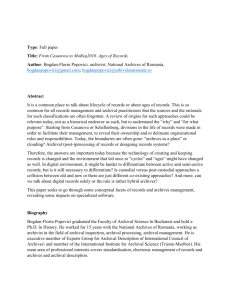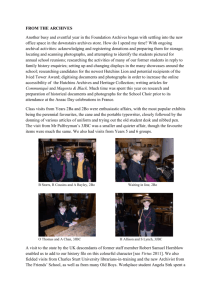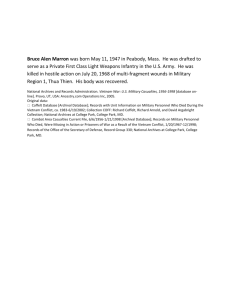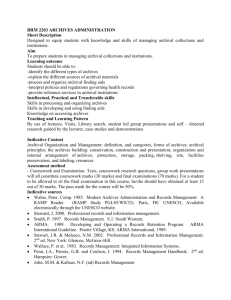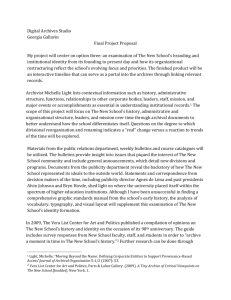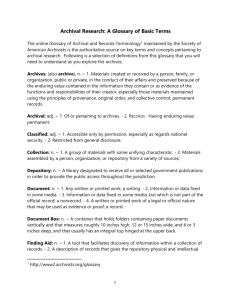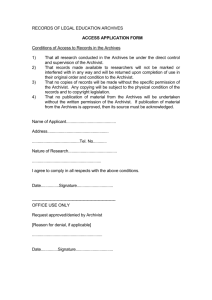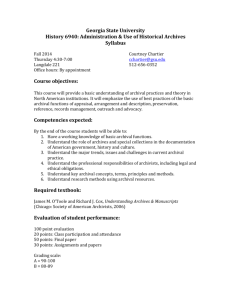September 1 - University at Albany
advertisement
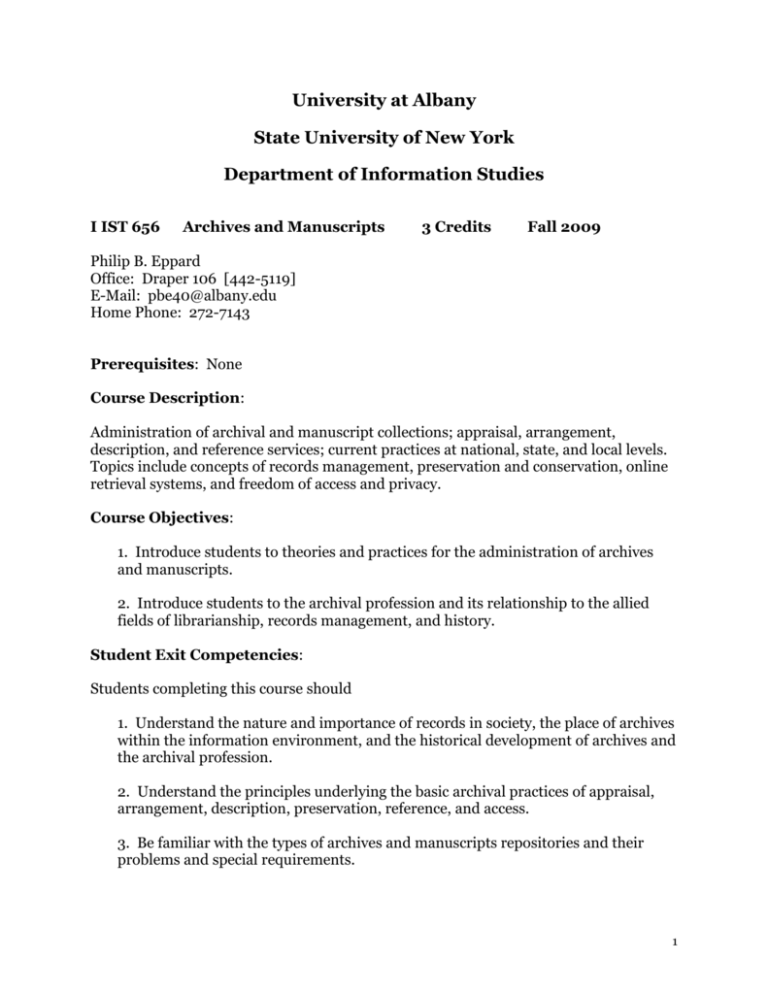
University at Albany State University of New York Department of Information Studies I IST 656 Archives and Manuscripts 3 Credits Fall 2009 Philip B. Eppard Office: Draper 106 [442-5119] E-Mail: pbe40@albany.edu Home Phone: 272-7143 Prerequisites: None Course Description: Administration of archival and manuscript collections; appraisal, arrangement, description, and reference services; current practices at national, state, and local levels. Topics include concepts of records management, preservation and conservation, online retrieval systems, and freedom of access and privacy. Course Objectives: 1. Introduce students to theories and practices for the administration of archives and manuscripts. 2. Introduce students to the archival profession and its relationship to the allied fields of librarianship, records management, and history. Student Exit Competencies: Students completing this course should 1. Understand the nature and importance of records in society, the place of archives within the information environment, and the historical development of archives and the archival profession. 2. Understand the principles underlying the basic archival practices of appraisal, arrangement, description, preservation, reference, and access. 3. Be familiar with the types of archives and manuscripts repositories and their problems and special requirements. 1 4. Be familiar with the role of information technology in modern archival management and the problems in the management and preservation of electronic records. 5. Be aware of the legal, ethical, and professional issues that archivists deal with and be able to discuss these issues. Course requirements: 1. Required readings. See the outline of course content. 2. Paper on an archives/records issue in the news: Write a 5-page analysis of the treatment of an archives/records issue in the news. Further details will be given in class. Due September 29. 3. Short review paper. Write a 1000-word review of the following two articles: Terry Cook, “Fashionable Nonsense or Professional Rebirth: Postmodernism and the Practice of Archives,” Archivaria 51(Spring 2001): 14–35 <http://journals.sfu.ca/archivar/index.php/archivaria/article/view/12792/13989> Brien Brothman, “The Past That Archives Keep: Memory, History, and the Preservation of Archival Records,” Archivaria 51(Spring 2001): 48–80. <http://journals.sfu.ca/archivar/index.php/archivaria/article/view/12794/13993> Due October 20. 4. Reference assignment: Locate archival and manuscript materials using published finding aids and Internet resources and write a brief assessment of the Web site of an archival repository. Due November 3. 5. Term paper. Write a paper of approximately 15-20 pages analyzing a particular issue or problem in the archives field. Papers should give evidence of wide reading in the archival literature. Further details will be provided in class. Topics and preliminary bibliography due no later than November 3. Papers due December 1. Evaluation of Student Performance will be based on: 1. 2. 3. 3. 5. Participation in class discussion 5% Archives/Records in the news paper 15% Short review paper 20% Reference assignment 10% Term paper 50% 2 Teaching Methodologies: 1. 2. 3. 4. Lectures Discussion Case/problem analysis Internet/MARC demonstration Statement on Academic Dishonesty: The Department of Information Studies takes academic dishonesty very seriously. Before taking classes within the Department of Information Studies, you should familiarize yourself with the department’s Academic Dishonesty Policy, available in both the department’s Graduate Handbook and online at <http://www.albany.edu/cci/informationstudies/resources.shtml> Professors reserve the right to add to the department’s policy as they see appropriate. Outline of Course Content and Required Readings: All of the readings in the course outline are required. Students should do the assigned readings before class and be prepared to discuss them. Most of the readings are on reserve in Dewey Library or through the ERes system on the University Libraries homepage. Others are accessible directly over the Internet. The basic texts for the course are: James M. O'Toole and Richard J. Cox. Understanding Archives & Manuscripts. Chicago: Society of American Archivists, 2006. Frank Boles. Selecting & Appraising Archives & Manuscripts. Chicago: Society of American Archivists, 2005. Kathleen D. Roe. Arranging & Describing Archives & Manuscripts. Chicago: Society of American Archivists, 2005. Mary Jo Pugh. Providing Reference Services for Archives & Manuscripts. Chicago: Society of American Archivists, 2005. American Archival Studies: Readings in Theory and Practice. Edited by Randall C. Jimerson. Chicago: Society of American Archivists, 2000. These five books are available for purchase directly from the Society of American Archivists at www.archivists.org. SAA members (including student members) receive a discount on all book purchases from SAA. A student membership in SAA costs $44, and you must provide a photocopy of your current student ID. 3 Key additional readings are taken from the following volumes: The Archival Imagination: Essays in Honour of Hugh A. Taylor. Edited by Barbara L. Craig. Ottawa: Association of Canadian Archivists, 1992. Karen Benedict, Ethics and the Archival Profession: Introduction and Case Studies. Chicago: Society of American Archivists, 2003. Michael J. Kurtz. Managing Archival & Manuscript Repositories. Chicago: Society of American Archivists, 2004. A Modern Archives Reader: Basic Readings on Archival Theory and Practice. Edited by Maygene F. Daniels and Timothy Walch. Washington, D.C.: National Archives and Records Service, 1984. Mary Lynn Ritzenthaler. Preserving Archives and Manuscripts. Chicago: Society of American Archivists, 1993. Political Pressure and the Archival Record. Edited by Margaret Procter, Michael Cook, and Caroline Williams. Chicago: Society of American Archivists, 2005 September 1 Introduction to the course requirements: Structure, readings, assignments. Introduction to archival terminology and functions. For reference on terminology throughout the course, consult: Richard Pearce-Moses, A Glossary of Archival and Records Terminology. Chicago: Society of American Archivists, 2005. Available on SAA web site: <http://www.archivists.org/glossary/> September 8 The nature of archives and manuscripts and the archival profession. Types of institutions and repositories. Relationships with other disciplines. The role of records in society. O'Toole and Cox, Understanding Archives and Manuscripts, pp. 1–43. John Fleckner, “‘Dear Mary Jane’: Some Reflections on Being an Archivist.” American Archival Studies, 21–28. [American Archivist 54(Winter 1991): 8–13.] Kenneth E. Foote, “To Remember and Forget: Archives, Memory, and Culture.” American Archival Studies, 29–46. [American Archivist 53(Summer 1990): 378–92.] 4 Hilary Jenkinson, “Reflections of an Archivist.” Modern Archives Reader, 15–21. Luciana Duranti, “Reliability and Authenticity: The Concepts and Their Implications.” Archivaria 39(Spring 1995): 5–10. <http://journals.sfu.ca/archivar/index.php/archivaria/article/view/12063/13035> James M. O'Toole, “The Symbolic Significance of Archives.” American Archival Studies, 47–72. [American Archivist 56(Spring 1993): 234–55.] Jay Atherton, “From Life Cycle to Continuum: Some thoughts on the Records Management–Archives Relationship.” Archivaria 21 (Winter 1985–86): 43–51. <http://journals.sfu.ca/archivar/index.php/archivaria/article/view/11233/12172> September 15 Historical development of recordkeeping, archival principles, and archives and manuscript collections. O'Toole and Cox, Understanding Archives and Manuscripts, pp. 45–86. Ernst Posner, “Some Aspects of Archival Development since the French Revolution.” Modern Archives Reader, 3–14. [American Archivist 3(July 1940): 159–72.] Judith M. Panitch, “Liberty, Equality, Posterity?: Some Archival Lessons from the Case of the French Revolution.” American Archival Studies, 101–22. [American Archivist 59(Winter 1996): 30–47.] JoAnne Yates, Control through Communication: The Rise of System in American Management (Baltimore: Johns Hopkins University Press, 1989), 21–64. Luke J. Gilliland-Swetland, “The Provenance of a Profession: The Permanence of the Public Archives and Historical Manuscripts Traditions in American Archival History.” American Archival Studies, 123–41. [American Archivist 54(Spring 1991): 160–75.] Charles M. Dollar, “Archivists and Records Managers in the Information Age.” Archivaria 36(Autumn 1993): 37–52. <http://journals.sfu.ca/archivar/index.php/archivaria/article/view/11933/12888> September 22 Guest Lecture: Geoffrey Williams, University Archivist. Class meets at the M. E. Grenander Department of Special Collections and Archives, 3rd floor, Science Library. O'Toole and Cox, Understanding Archives and Manuscripts, pp. 87–146. 5 Browse the web page of the M. E. Grenander Department of Special Collections and Archives: http://library.albany.edu/speccoll/ September 29 Introduction to appraisal theory and practice. ARCHIVES/RECORDS IN THE NEWS PAPER DUE. Boles, Selecting and Appraising Archives and Manuscripts, 1–120. T. R. Schellenberg, The Appraisal of Modern Public Records. Bulletin of the National Archives, No. 8. <http://www.archives.gov/research/alic/reference/archives-resources/appraisalforeword.html> [Excerpts from this report are also available in A Modern Archives Reader, 57–70.] Frank Boles & Julia Marks Young, “Exploring the Black Box: The Appraisal of University Administrative Records.” American Archival Studies, 279–300. [American Archivist 48(Spring 1985): 121–40.] Helen W. Samuels, “Who Controls the Past.” American Archival Studies, 193-210. [American Archivist 49(Spring 1986): 109–24.] Richard J. Cox, “The Documentation Strategy and Archival Appraisal Principles: A Different Perspective.” American Archival Studies, 211–41. [Archivaria 38(Fall 1994): 11–36.] James M. O’Toole, “On the Idea of Uniqueness.” American Archival Studies, 245–77. [American Archivist 57(Fall 1994): 632–58.] National Archives and Records Administration, “Intrinsic Value in Archival Material.” <http://www.archives.gov/research/alic/reference/archives-resources/archivalmaterial-intrinsic-value.html> October 6 Recent trends in appraisal theory. Acquisition and accessioning practices. Boles, Selecting & Appraising Archives & Manuscripts, 121–57. Terry Cook, “Mind over Matter: Towards a New Theory of Archival Appraisal,” in The Archival Imagination: Essays in Honour of Hugh A. Taylor, ed. Barbara L. Craig, 38– 70. 6 Terry Eastwood, “Toward a Social Theory of Appraisal,” in The Archival Imagination: Essays in Honour of Hugh A. Taylor, ed. Barbara L. Craig, 71–89. Mark Greene, “‘The Surest Proof’: A Utilitarian Approach to Appraisal.” American Archival Studies, 301–42. [Archivaria 45 (Spring 1998): 127–69.] Leonard Rapport, “No Grandfather Clause: Reappraising Accessioned Records.” Modern Archives Reader, 80-90. [American Archivist 44(Spring 1981): 143–50.] Faye Phillips, “Developing Collecting Policies for Manuscript Collections.” American Archivist 47(Winter 1984): 30–44. Judith Endelman, “Looking Backward to Plan for the Future: Collection Analysis for Manuscript Repositories.” American Archivist 50(Summer 1987): 340–55. Timothy Ericson, “At the ‘Rim of Creative Dissatisfaction’: Archivists and Acquisition Development.” American Archival Studies, 177–92. [Archivaria 33(Winter 1991-92): 66–77.] October 13 Arrangement of archives and manuscripts. Processing Collections. Roe, Arranging & Describing Archives & Manuscripts, 1–100. T. R. Schellenberg, “Archival Principles of Arrangement.” Modern Archives Reader, 149–61. [American Archivist 24(January 1961): 11–24.] David A. Bearman & Richard H. Lytle, “The Power of the Principle of Provenance.” American Archival Studies, 345–60. [Archivaria 21(Winter 1985-86): 14–27.] Mark A. Greene & Dennis Meissner, “More Product, Less Process: Revamping Traditional Archival Processing.” American Archivist 68(Fall/Winter 2005): 208–63. Christine Weideman, “Accessioning as Processing.” American Archivist 69(Fall/Winter 2006): 274–83. October 20 Descriptive standards and practices in archives. Use of the MARC format and Encoded Archival Description. Introduction to the Reference Assignment. SHORT REVIEW PAPER DUE. Roe, Arranging & Describing Archives & Manuscripts, 111–74. 7 Elizabeth Yakel, “Archival Representation.” Archival Science 3(2003): 1–25. Lisa B. Weber, “Archival Description Standards: Concepts, Principles, and Methodologies.” American Archivist 52(Fall 1989): 504–13. Avra Michelson, “Description and Reference in the Age of Automation.” American Archival Studies, 361–79. [American Archivist 50(Spring 1987): 192–208.] Steven L. Hensen, “‘NISTF II’ and EAD: the Evolution of Archival Description.” American Archivist 60(Summer 1997): 284–96. Daniel V. Pitti, “Encoded Archival Description: The Development of an Encoding Standard for Archival Finding Aids.” American Archival Studies, 395-414. [American Archivist 60(Summer 1997): 268–83] For review: Describing Archives: A Content Standard. Chicago: Society of American Archivists, 2004. October 27 Archival reference services and user studies. Introduction to the Reference Assignment. Pugh, Providing Reference Services for Archives & Manuscripts, 1–147, 249-70. Elsie T. Freeman, “In the Eye of the Beholder: Archives Administration from the User's Point of View.” American Archival Studies, 417–31. [American Archivist 47(Spring 1984): 111–23.] Paul Conway, “Facts and Frameworks: An Approach to Studying the Users of Archives.” American Archival Studies, 433–48. [American Archivist 49(Fall 1986): 393–407.] Elizabeth Yakel & Laura L. Bost Hensey, “Understanding Administrative Use and Users in University Archives.” American Archival Studies, 449–71. [American Archivist 57(Fall 1994): 596–615. Elizabeth Yakel, “Thinking Inside and Outside the Boxes: Archival Reference Services at the Turn of the Century.” Archivaria 49(Spring 2000): 140–60. <http://journals.sfu.ca/archivar/index.php/archivaria/article/view/12742/13927> November 3 Access to archives. Preservation management for archives and manuscripts. TERM PAPER TOPICS DUE. REFERENCE ASSIGNMENT DUE. Pugh, Providing Reference Services for Archives & Manuscripts, 149–247. 8 ALA-SAA Joint Statement on Access: Guidelines for Access to Original Research Materials. <http://www.archivists.org/statements/alasaa.asp> ALA/SAA Joint Statement on Access to Research Materials in Archives and Special Collections Libraries. Draft Document <http://www.archivists.org/news/2008ALA_SAA-call.asp> Elena S. Danielson, “The Ethics of Access.” American Archivist 52(Winter 1989): 52– 62. Ritzenthaler, Preserving Archives and Manuscripts, pp. 1–132. Paul Conway, “Archival Preservation Practice in a Nationwide Context.” American Archival Studies, 495–517. [American Archivist 53(Spring 1990): 204–22.] James M. O'Toole, “On the Idea of Permanence.” American Archival Studies, 475–94. [American Archivist 52(Winter 1989): 10–25.] November 10 The impact of electronic records and recordkeeping systems on archives. Kenneth Thibodeau, "The Electronic Records Archives Program at the National Archives and Records Administration: The Challenge of Electronic Records." First Monday 12(July 2007). <http://firstmonday.org/issues/issue12_7/thibodeau/index.html> David Bearman & Margaret Hedstrom, “Reinventing Archives for Electronic Records: Alternative Service Delivery Options.” American Archival Studies, 549–67. [Electronic Records Management Program Strategies, ed. Margaret Hedstrom. Pittsburgh: Archives and Museum Informatics, 1993, pp. 82–98.] Linda Henry, “Schellenberg in Cyberspace.” American Archival Studies, 569–88. [American Archivist 61(Fall 1998): 309–27.] Peter B. Hirtle, “Archival Authenticity in a Digital Age,” in Authenticity in a Digital Environment. Washington, D.C.: Council on Library and Information Resources, 2000. <www.clir.org/pubs/reports/pub92/hirtle.html> InterPARES Project Preservation Task Force, “How to Preserve Authentic Electronic Records.” The Long-term Preservation of Authentic Electronic Records: Findings of the InterPARES Project, Appendix 6. <http://www.interpares.org/book/index.cfm> 9 InterPARES 2 Project, A Framework of Principles for the Development of Policies, Strategies and Standards for the Long-term Preservation of Digital Records. <http://www.interpares.org/ip2/display_file.cfm?doc=ip2(pub)policy_framework_doc ument.pdf> November 17 Management, outreach, and advocacy. Kurtz, Managing Archival & Manuscript Repositories, 1–88, 159–84. Randall C. Jimerson, “Redefining Archival Identity: Meeting User Needs in the Information Society.” American Archival Studies, 607–17. [American Archivist 52(Summer 1989): 332–40.] John Grabowski, “Keepers, Users, and Funders: Building an Awareness of Archival Value.” American Archival Studies, 619–29. [American Archivist 55(Summer 1992): 464–72.] November 24 Legal and ethical issues in archives. Society of American Archivists, Code of Ethics for Archivists. <http://www.archivists.org/governance/handbook/app_ethics.asp> Karen Benedict, Ethics and the Archival Profession: Introduction and Case Studies, 1– 20. Glenn Dingwall, “Trusting Archivists: The Role of Archival Ethics Codes in Establishing Public Faith.” American Archivist 67(Spring/Summer 2004): 11–30. Peter B. Hirtle, “Copyright Term and the Public Domain in the United States 1 January 2009 <http://www.copyright.cornell.edu/training/Hirtle_Public_Domain.htm> Menzi L. Behrnd-Klodt, “Access to Public Records.” In Navigating Legal Issues in Archives. (Chicago: Society of American Archivists, 2008), 155–65. Chris Hurley, “The Role of the Archives in Protecting the Record from Political Pressure,” in Political Pressure and the Archival Record, 152-71. [Also available at <http://www.mybestdocs.com/hurley-c-lucas-keynote0703.htm>] 10 December 1 Current state and future prospects of the archival profession. TERM PAPER DUE. Mark A. Greene, “The Power of Archives: Archivists’ Values and Value in the Postmodern Age. American Archivist 72(Spring/Summer 2009): 17–41. Victoria Irons Walch, “A*Census: A Closer Look.” American Archivist 69(Fall/Winter 2006): 327–48. Randall C. Jimerson, “American Archivists and the Search for Professional Identity.” American Archival Studies, 1–17. J. Gordon Daines III and Cory L. Nimer, eds., The Interactive Archivist: Case Studies in Utilizing Web 2.0 to Improve the Archival Experience. (2009) <http://lib.byu.edu/sites/interactivearchivist/> 11

